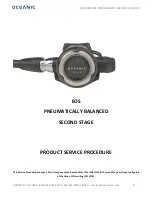
Section 6: Clarius
Model 4200A-SCS Parameter Analyzer Reference Manual
6-40
4200A-901-01 Rev. C / February 2017
Compliance limits
You can set a limit that stops a SMU from sourcing a current or voltage that is more than that limit.
This limit is called compliance and helps prevent damage to the device under test (DUT). The SMU
will not exceed the maximum limit set for compliance. When a SMU is acting as a current source, the
voltage is clamped at the compliance value; conversely, the current is clamped at the compliance
value when the SMU is acting as a voltage source.
When a SMU reaches compliance, it continues to make measurements. However, the measurement
stays at the value it was at when compliance occurred. For example, if you are sourcing voltage and
the compliance is set to 100 mA, it continues to measure 100 mA after compliance is reached. The
voltage, however, is not at the programmed value.
You can stop the test if the source reaches compliance. Refer to
Compliance exit condition options
(on page 6-88) for detail.
If you set a specific measurement range, compliance can also be restricted by the range. Compliance
must be more than 11% of the measurement range. If not, an event is generated and the compliance
setting is automatically changed to the maximum compliance value for the selected range. For
example, if compliance is set to 1 V and the measurement range is 200 mV, output voltage will clamp
at 210 mV. If you attempt to change compliance to a value that is not appropriate for the selected
range, compliance is not changed and a warning is generated. You must change the range before
you can select the new compliance value. If you set the measurement range to be automatically
selected, the measurement range does not affect compliance.
The lowest allowable compliance is based on the load and the source value. For example, if you are
sourcing 1 V to a 1
kΩ resistor, the lowest allowable current compliance is 1 mA (1 V/1 kΩ = 1 mA).
Setting a compliance lower than 1 mA limits the source.
For another example, assume the following conditions:
•
Current compliance: 10 mA
•
Voltage sourced by the instrument: 10 V
•
DUT resistance: 10 Ω
With a source voltage of 10 V and a DUT resistance of 10 Ω, the current through the DUT should be
10 V / 10
Ω = 1 A. However, because compliance is set to 10 mA, the current cannot exceed 10 mA,
and the voltage across the resistance is limited to 100 mV. In effect, the 10 V voltage source is
transformed into a 10 mA current source.
In steady-state conditions, the set compliance value restricts the instrument output unless there are
fast transient load conditions.
When measurement autorange is disabled, the maximum and minimum compliance values cannot be
set below the minimum value. When autorange is enabled, the programmed compliance value cannot
be set below 10 nA when sourcing voltage, or below 20 mV when sourcing current.
















































